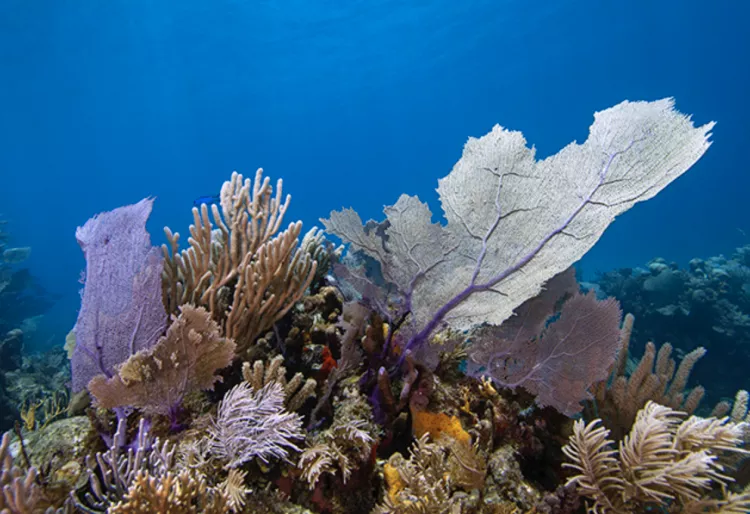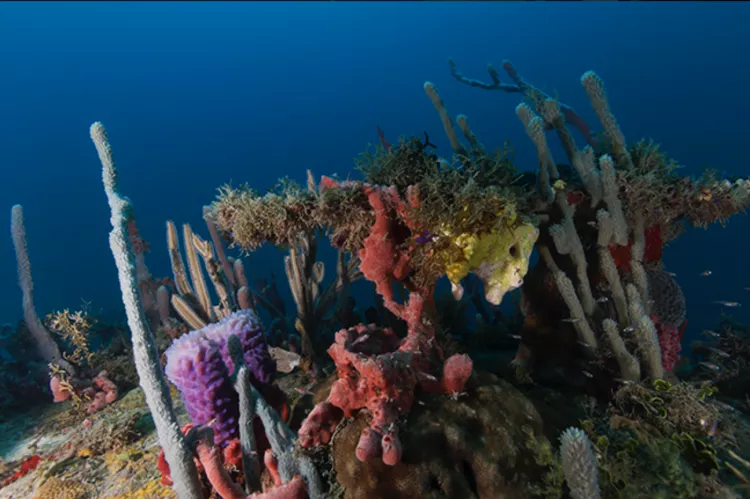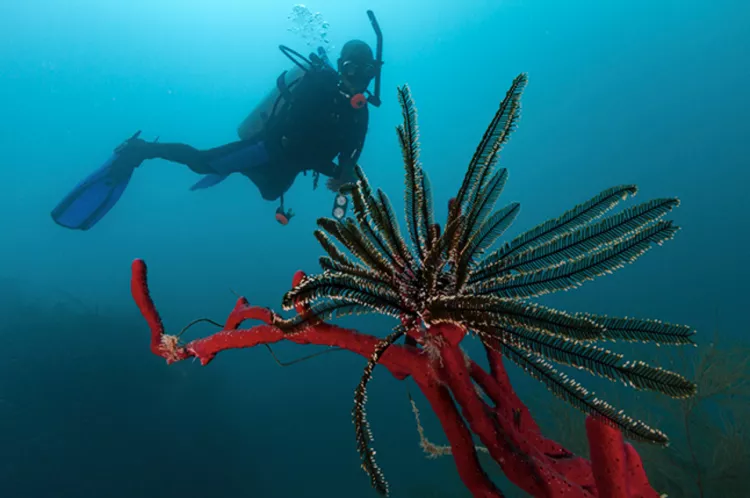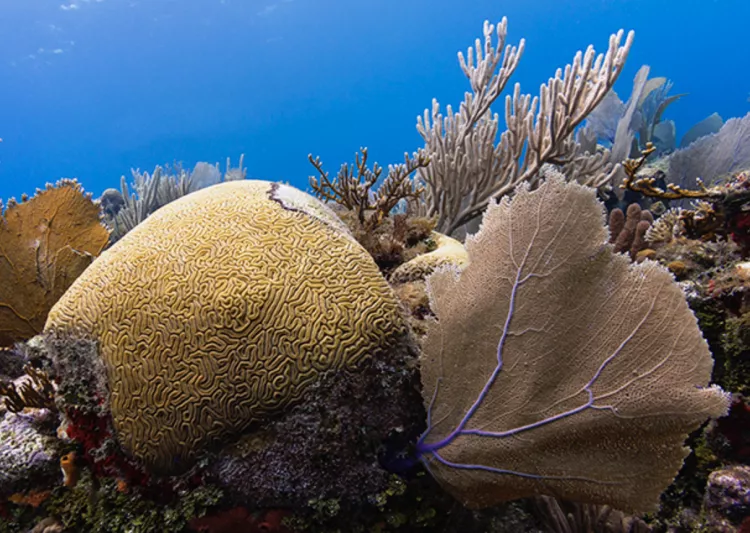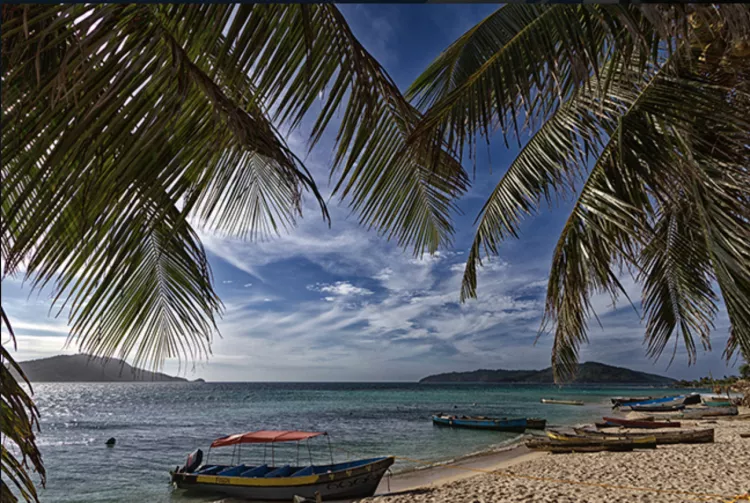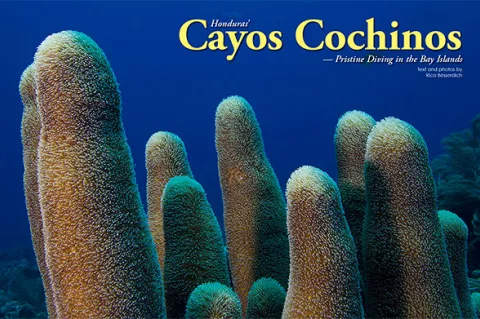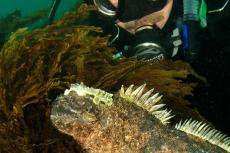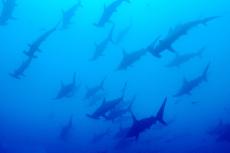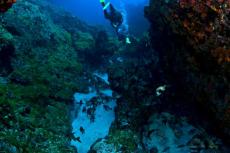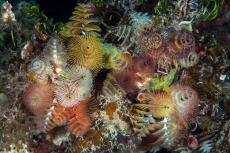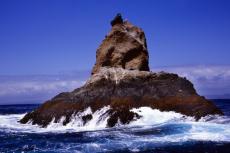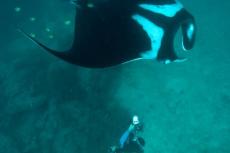The Cayos Cochinos is a group of small islands located just between the mainland of Honduras and Roatán. Within this group are two small islands—Cayo Menor and Cayo Grande—and 13 more small coral cays situated 30km (19mi) northeast of La Ceiba on the northern shores of Honduras.
Contributed by
Factfile
Rico Besserdich is a widely published German photographer, journalist and artist based in Turkey. See: www.maviphoto.com
We can't say Honduras is unknown to scuba divers. Roatán is known and so is Utila; both are dive locations that attract scuba divers, mostly from the United States, and they provide plenty of dive centers and all the dive logistics that keen divers expect.
The Cayos are part of the Bay Islands (Islas de la Bahía). Some people still like to call them Hog Islands, referring to the time the famous pirate Henry Morgan (ca. 1635–1688)—according to legend—"planted" hogs on these cays so he and his fellow pirates would have meat on their return trips. [1]
Around 100 people (the Garifuna) live on these islands, and yes, scuba diving is possible here! "The Cayos Cochinos reefs are the least disturbed ecosystem in the Bay Islands," stated Dr Matthias Hammer in National Geographic. "The waters around this collection of coral cays [...] are a marine biologist's dream: protected by the government, off-limits to commercial divers and fishermen, and busy with creatures that may not yet have names." The German conservation biologist made several expeditions to this region. [2]
Established as a key area of the Mesoamerican Barrier Reef System (the world's second largest barrier reef, right after Australia's Great Barrier Reef), the Cayos and surrounding waters were declared a marine reserve in 1993, in order to protect all marine and terrestrial flora and fauna within a 460 sq km area. Laws prohibit all commercial fishing, netting and trapping within the marine park. The local Garifuna people are permitted to fish with handlines, but are prohibited from netting and spearfishing. Since 1994, the Honduras Coral Reef Foundation (HCRF) has been in charge of preserving the natural beauty of the area.
The HCRF has a marine biology research center on Cayo Menor (the smaller of the two main islands) where scientists and students of marine biology from all over the world are welcome as guests to do their field research. Accommodation in cozy bungalows and catering are provided.
Diving style
I have to confess that I love the oceans and all marine life, but I am very far from being even close to a marine biologist. I apologize in advance for my inability to give proper identification to the living things I see during my dives in Cayos Cochinos. But what I would like to share are my visual impressions and a few of my adventures, experienced as a diver and photographer.
The luxury of diving places where only very few have dived before requires a readiness for adventure and a willingness to accept compromises. But it all pays back a hundredfold.
If you are used to staying on huge liveaboard dive boats, where staff prepare your scuba gear while you sip your morning coffee on the upper deck, you might need to re-think your expectations here, because diving on Cayos Cochinos is different.
During my stay, I saw that most visitors to Cayos Cochinos were day guests who joined a 45-minute boat ride from the city of La Ceiba (on the mainland) and spent their day visiting the islands, looking out for the pink boa constrictor (it is only found there), hiking the trails through the jungle, going snorkeling or perhaps scuba diving. But most of them were more interested in the pink boa constrictor and in the souvenirs some local Garifuna people were selling, despite the fact that there were dive centers in La Ceiba that provided everything one would need for scuba diving.
Getting there
After a 34-hour trip flying from Izmir in Turkey to Istanbul, then to London and Newark, and finally to San Pedro, I arrived in Honduras. What time was it? Ah, nine hours earlier than home! I then took a two-and-a-half hour car ride from San Pedro to La Ceiba, the city that is also widely known as "Gate to the Bay Islands". It is also renowned as Honduras' party town and it is here that they perform some dances where the "hips don't lie".
When in new places, I always love to check out the marina. Well, there was nothing of the sort to check out in La Ceiba, as the boat picked me up directly from the beach of my hotel. That was pretty cool. My dive boat was actually more of a sort of power canoe, but that didn’t matter. The boats were designed to pick guests up from the beach and take them to Cayos Cochinos as fast as possible.
The approach to Cayos Cochinos gives one a sort of Robinson Crusoe feeling: there was sand, palm trees and everything one would expect from a Caribbean island—no cars, no roads, no bikes and, not to mention, the crystal clear turquoise waters. Production teams of the television reality show Survivor, from Spain, Italy, Greece and Israel, do sometimes hire one of the smaller islands for their production. But don't believe that all those Survivor candidates actually stay on the island with one shack and three palm trees all the time—I have seen them enjoying happy hour at the hotel bar.
The underwater world
Well, I think I am expected to stay very serious here and not drift into euphoria when talking about the underwater world of Cayos Cochinos. But that is easier said than done after diving here.
I have never seen such rich diversity, especially of corals, in any of my 4,000 dives worldwide. There were plenty of different species of hard and soft corals growing almost to the surface of the water. The soft corals were waving in the currents, following the gentle music of the sea. I felt like I was the first diver ever to dive these waters.
Yes, we divers are not supposed to touch anything—"leaving nothing behind but bubbles". However, at dive sites around the world where a growing dive industry performs thousands of dives and every operator involved seems to just have profit in mind, responsible divers can do the best they can to not touch corals, but sooner or later, we will notice the negative effects of intensive diving at such areas anyway.
Cayos Cochinos is different in this regard. There are limits and restrictions to the number of divers that could be at any one dive site, and the entire concept of scuba diving activities done here followed the strict principles of ecotourism, promoting a deeper understanding of the fragility of coral reefs. Quality, rather than quantity.
Although no coffee was served during the boat trip, there was world-class diving at top-quality spots; and yes, one had the dive sites (almost) all to oneself. While I was diving there, I was accompanied by the dive guide and one of the marine biologists from the HCRF. There were no other dive boats in sight, and we had the reefs all to ourselves.
Pelikano Uno. In terms of diving and underwater photography, I would say that Pelikano Uno (close to Cayos Mayor) was a dive spot every keen diver and photographer should put on his or her bucket list. The boat anchored at the edge of a reef, which was basically shaped like a long saddle. We descended to 4m and found ourselves surrounded by thousands of soft corals. It was actually impossible to find empty space—meaning, a space where no coral was growing. We then continued on our way with the saddle-shaped reef to our left. The reef descended in cascades and came to an area where one could find beautiful isolated corals. Again, there were plenty of them. Once our pressure gauges demanded that we turned back, we just ascended back to the top of the reef, following the saddle-shaped reef until we spotted the boat. If one prefers to stay longer, one can find plenty of things to see in just five to six meters depth. The current was no big deal—just for the record, in June, which was actually the off season, the water was 27°C. A 3mm shorty would do.
Other dive spots worth mentioning include El Avión, Roatan Banks, Punta Pelicano, Cabeza d León, Arena La Grupera, El Jardín, Cayo Timon and Wilfried's Bell.
Wrecks. The highlight of all the dive sites was, of course, the corals, but there were also two wrecks to explore. El Avion is the wreck of a smaller aircraft (probably a Piper plane), which is covered by plenty of different corals. Wilfried's Bell is the wreck of a Bell helicopter, which was dropped down on the reef in 2008. The chopper rests nicely isolated on sandy ground, a cool playground for underwater photographers if the visibility is good (which, sadly, was not the case when I dived there).
El Jardin. El Jardin offered nice underwater topography with several reef pinnacles, sandy areas with sand eels and also a couple of enjoyable swim-throughs. Very close to this site is a small bay where you can leave the boat, enter the jungle and find yourself some fresh fruit. But beware where you step, because there are fragile corals everywhere, even in 50cm shallow water.
Roatan Banks. Roatan Banks is a massive reef in-between Cayos Cochinos and Roatan. Jacks, barracuda and snapper, turtles, rays, groupers and every type of coral and reef fish could be found here. This, however, pretty much depends on the time of the year. February to May are good times to visit. When I was there in June, the rainy season had started, resulting in a bit less fish around.
The Roatan Banks was, with a depth of 30m, the deepest dive site of my stay. All the other sites I dived at were at a depth range of five to 20m and, as such, suitable for divers of all levels.
There are roughly a dozen different sites to dive in the waters of Cayos Cochinos, but due to the outstanding diversity, you can easily dive every spot two to three times and not discover everything. I dove Pelikano Uno three times and felt as if I had not even discovered 50 percent of that dive site.
Notes to underwater photographers
Bring everything you’ve got. There is plenty to shoot for wide-angle and macro fans alike. Keep in mind that Cayos Cochinos is one of the most untouched dive areas on the planet. There is no need to swim around for a long time, searching for interesting subjects to shoot. It is more about coming to a decision about what not to shoot, as you would be surrounded by plenty of life and photogenic subjects.
Some areas close to the islands are so shallow that snorkeling with your camera is the proper option, providing you with lots of photographic opportunities, even when working with ambient light only.
Underwater, visibility starts to drop by the beginning of June. The best underwater visibility I found was roughly at 25m; the worse was at just six meters. But I was told that in the months prior to June, visibility of 30m to 35m was considered normal, with visibility of over 40m on some lucky days.
For those interested in marine biology, I suggest you contact the research station of the Honduras Coral Reef Foundation at Cayos Cochinos. They are the ones who best know the place and everything that grows, crawls and swims there. There is even an option to dive with one of their marine biologists. Remember what National Geographic said about the place: Plenty of species in those waters do not even have a name yet. So, if you ever want to discover a new marine species and give it a name, here is your chance!
How to get there
There are several regular flights from Newark, Houston, Fort Lauderdale, Atlanta and Miami to San Pedro Sula, Honduras. It is about 2.5 hours by car (Transfers are offered by tour operators and dive centers.) from Pedro Sula to reach La Ceiba (or just hop on a short chartered flight), the Gate to the Bay Islands. Twice a week, there is a direct flight from Grand Cayman to La Ceiba. If you are already on Utila or Roatan, you can reach Cayos Cochinos by private boat charter. From the island of Guanaja, there is a ferry that goes to La Ceiba.
Accommodation and diving
The most relaxed and comfortable way to dive at Cayos Cochinos is to stay in the Palma Real Hotel and let its new dive center—the Diving Center Palma Real Hotel, located right at the hotel's pool—arrange your dives. Hop on the speedboat right at the hotel's beach to enjoy a couple of dives at Cayos Cochinos and make a stopover at the island of Chachauate to meet the Garifuna people. You will be back at the hotel by beer o'clock. Alternate places to stay (that do not have their own dive center but are connected to one) include La Delphina, Rainbow Village Hotel and Partenon Beach Hotel.
Things to know
- Beware of sandflies! Nasty small monsters. Better bring some spray.
- Honduras produces some of the finest rums of the world and the country’s Imperial beer is not too bad, either.
- Bring sun protection and lots of water to drink. It is very, very hot.
- The currency of Honduras is the Honduras Lempira, but US Dollars are widely accepted. Exchange rate: 1 USD = 22 Lempiras.
SOURCES:
[1] https://en.wikipedia.org/wiki/Henry_Morgan
[2] https://en.wikipedia.org/wiki/Cayos_Cochinos#cite_note-NatGeo-1

